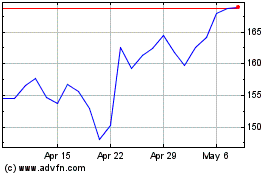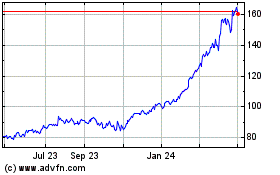By Theo Francis
If the U.S. imposes sweeping tariffs on imports from China early
next month as planned, the levies will be felt not only in ports
ringing the Pacific, but also across companies, product lines and
factory towns in the U.S.
For General Electric Co., that includes its business making
magnetic resonance imaging machines, or MRIs, many of which are
assembled at plants in Florence, S.C., and Waukesha, Wisc.
GE, which is struggling to boost profits and revamp its
operations after a series of missteps, has argued to federal policy
makers that it is counterproductive to impose tariffs on components
the company imports from its own plants in China, including some
assembled using parts that were originally made in the U.S.
"Putting tariffs on the parts they produce will not hurt Chinese
businesses or sway Chinese decision makers," GE executive Karan
Bhatia said in a May hearing held by a committee of the Office of
U.S. Trade Representative. "Rather, they hurt U.S. companies that
own these facilities, as well as the U.S. workers and suppliers who
rely on these parts from China to make world-class products in the
United States."
GE's MRI business is just one part of the company's health-care
division, which last year accounted for about 16% of companywide
sales, or $19 billion. Still, it offers a window into the complex
interconnections of global trade, where components made in one
country get assembled in another -- and, once in finished form, may
be sold back into the first. Some parts make more than a single
roundtrip.
"Global supply chains have become so integrated over the last
few decades that it's really hard to put tariffs in place that are
not going to harm some domestic manufacturers," said William Hauk,
an economics professor at the University of South Carolina.
The administration has said tariffs are needed to prevent China
from dominating key industries with unfair state subsidies. A
senior administration trade official said a forthcoming
product-by-product exemption process will seek to take into account
the kinds of scenarios raised by GE, without creating so many
exceptions that it weakens the tariffs' impact.
"We are being as sensitive as we can to these types of problems,
given the overall problem that we're trying solve," the official
said. Still, he acknowledged, some U.S. companies could see costs
rise.
GE, which makes everything from LED bulbs to jumbo jet engines,
has said it expected to be affected by levies imposed on about
three-quarters of an initial list of products facing U.S. tariffs.
But it considers some three dozen products to be critical, in part
because obtaining them elsewhere will prove difficult or require
months to arrange.
That shorter list includes parts for aircraft-engine turbines,
submersible electric pumps, locomotives and steam boilers. It also
includes key parts for X-ray machines and other equipment made by
GE Healthcare -- including MRIs.
GE sells its U.S.-made MRIs for anywhere from $500,000 to $10
million depending on service and other options, analysts say.
Nearly $1 of every $5 in circuit boards and other components for
the scanners is imported from China, the company said.
Some analysts expect the ultimate impact of the China tariffs on
GE to be muted. Chinese imports make up only part of the
manufacturing cost, and end-users will likely be reluctant to
switch brands of complex machinery for a relatively small savings,
said Nicholas Heymann, an analyst for William Blair & Co.
Moreover, competitors, who also manufacture in the U.S., face the
same tariffs.
All told, GE Healthcare's MRI business directly employs about
950 people in the U.S., the company said, plus more who spend at
least part of their time on the products, such as by selling or
servicing multiple products.
At GE's Florence location, workers make the giant magnets at the
heart of the MRI scanners -- each magnet can weigh as much as 9
tons -- and assemble the "cabinet," which contains electronics and
much of the rest of what makes the scanners work. Workers in
Waukesha, a town that is home to about 72,000 people, also assemble
MRI cabinets.
Florence's mayor, Stephen Wukela, said GE has employed people
for decades in the 38,000-person town and is an important part of
an expanding economy that also boasts a paper mill and an Otis
Elevator plant. The region is already feeling the pinch from rising
construction costs, exacerbated by separate U.S. tariffs on steel,
aluminum and lumber.
"If tariffs spread into more products, then there's more
anxiety," said Mr. Wukela, who has run as a Democrat.
In Wisconsin, makers of industrial equipment and parts are also
seeing costs rise with tariffs on Canadian steel, aluminum and
lumber, said Noah Williams, director of the University of
Wisconsin's Center for Research on the Wisconsin Economy.
Still, he added, "the economy is doing relatively well -- this
is a shock, nobody likes it, but they feel like they can absorb it
for now."
Like other companies, GE isn't simply waiting for tariffs to
drive up prices. Mr. Bhatia, GE's president for government affairs
and a former U.S. trade official, has pushed for broad exceptions
for certain imports from China, including those made at
U.S.-controlled factories and those with a significant proportion
of U.S.-made components. The company plans to seek exemptions for
specific products where possible.
The company also is exploring how it could revamp its supply
chain to produce more of the components elsewhere in the world. But
that can't happen quickly, Mr. Bhatia has said. Stringent U.S.
quality and safety rules for medical equipment mean new factories
can take a year or more to bring on line.
The stakes are higher for companies like GE that own the
factories producing their imported parts, said Gary Hufbauer, a
senior fellow at the Peterson Institute for International
Economics, a Washington, D.C., think tank. In addition to operating
costs for ramping up production in a new location, they may also
have to try to sell or repurpose their specialized factories in
China.
"The factory may become economically obsolete even though it's
technically very good," Mr. Hufbauer said.
In the meantime, GE could find it tough to pass the cost of the
tariff on to the buyers of its MRI scanners. Three-quarters of GE
Healthcare's medical equipment is sold within the U.S., much of it
to hospitals and other buyers facing tight spending constraints.
The rest is exported to markets, including in China, where
competitors aren't troubled by the U.S. tariffs. Alternatively, GE,
like other industrial companies, could absorb the tariffs, reducing
profit margins in the process.
"Either consumers bear more cost, or we bear the cost and it
ultimately flows down to investment expenditures," Mr. Bhatia said
in an interview. "Either way, you're talking about bad things
happening, ultimately, to the economy."
Write to Theo Francis at theo.francis@wsj.com
(END) Dow Jones Newswires
June 24, 2018 10:10 ET (14:10 GMT)
Copyright (c) 2018 Dow Jones & Company, Inc.
GE Aerospace (NYSE:GE)
Historical Stock Chart
From Mar 2024 to Apr 2024

GE Aerospace (NYSE:GE)
Historical Stock Chart
From Apr 2023 to Apr 2024
